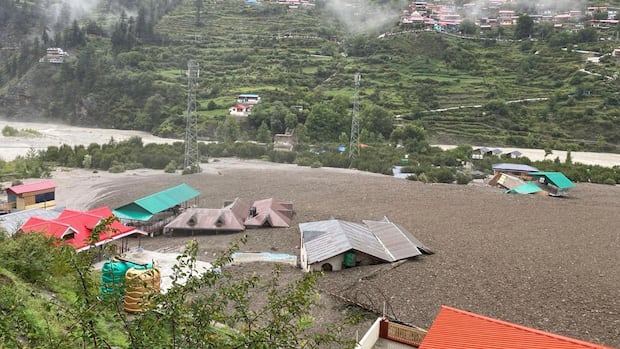Flash floods in northern India kill at least 4, trapping others under debris
India's weather agency forecasts more heavy rains this week
Flash floods swept away several homes and shops in northern India, killing at least four people and leaving many others trapped under debris, officials said Tuesday.
Local television channels showed flood waters surging down a mountain and crashing into Dharali, a Himalayan mountain village in the Uttarkashi district of Uttarakhand state. The flood waters inundated homes, swept away roads and destroyed a local market.
"About a dozen hotels have been washed away and several shops have collapsed," said Prashant Arya, an administrative officer, adding that rescuers, including the Indian army and police, were searching for the missing. Uttarakhand Chief Minister Pushkar Singh Dhami said rescue agencies were working "on a war footing."
"We are doing everything possible to save lives and provide relief," he said in a statement.
India's National Disaster Management Authority said it had requested three helicopters from the federal government to assist in the rescue and relief operations as rescuers struggled to access the remote terrain.
Officials have not provided a figure for those trapped or missing.
India's weather agency has forecast more heavy rains in the region in the coming days. Authorities have asked schools to remain closed in several districts, including Dehradun and Haridwar cities.
Sudden, intense downpours over small areas known as cloudbursts are increasingly common in Uttarakhand, a Himalayan region prone to flash floods and landslides during the monsoon season. Cloudbursts have the potential to wreak havoc by causing intense flooding and landslides, impacting thousands of people in the mountainous regions.
More than 6,000 people died and 4,500 villages were affected when a similar cloudburst devastated Uttarakhand state in 2013.
Experts say cloudbursts have increased in recent years partly due to climate change, while damage from the storms also has increased because of unplanned development in mountain regions.
The flooding in northern India is the latest in a series of disasters that have battered the Himalayan mountains, which span across five countries, in the last few months.
Flooding and landslides as a result of heavy rains and glaciers melting due to high temperatures have killed more than 300 people in Pakistan, reported the country's disaster agency. In 2024 alone, there were 167 disasters in Asia — including storms, floods, heat waves and earthquakes — which was the most of any continent, according to the Emergency Events Database maintained by the University of Louvain in Belgium. These led to losses of over $32 billion US, the researchers found.
A 2023 report by Nepal-based International Centre for Integrated Mountain Development found that glaciers are melting at unprecedented rates across the Hindu Kush and Himalayan Mountain ranges. The study found that at least 200 of the more than 2,000 glacial lakes in the region are at risk of overflowing, which can cause catastrophic damage downstream.

